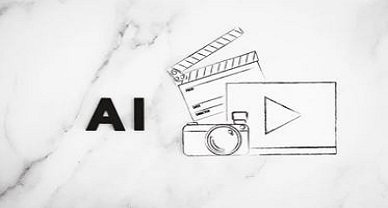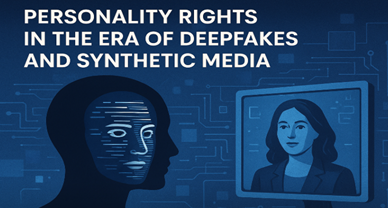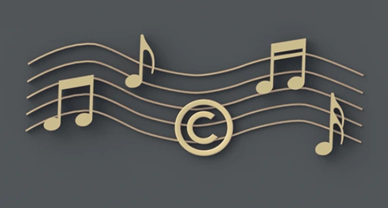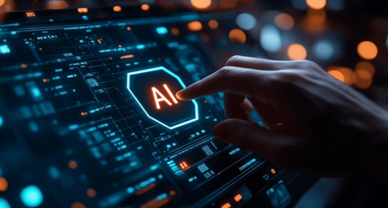Copyright and Artificial Intelligence in Music Creation
Abstract
The near-seamless hybrid of Artificial Intelligence (AI) and music creation has sparked a fascinating and deeply complex legal question of late – who or what owns the melody; the human or the machine? Some might argue that it’s the person who’s actually creating the music using AI, while others would say that the person feeding the relevant data to the AI is the owner of said music, as it’s their original content that the aforementioned later assembled.
While traditional copyright protects human-authored works, the lack of a singular human creator in AI-powered music throws a wrench in the system.[1] This Paper explores the potential justifications for and against copyright protection for music composed by artificial intelligence (“AI”). Infringement is less likely when the music is produced by AI without any human authorship, but how does the lack of human authorship affect copyright protection considerations? The Paper considers how the existing music works that AI learns from and infringes upon may also affect the justifications for copyright protection for that music composed by AI. The Paper also briefly examines the possible economics of providing copyright protection for AI-composed music, or of refusing to recognize such music as copyrightable, on the music industry.
The various copyright landscapes around the world are then described as a distancing from the sole focus of this Paper: the copyright landscapes of the United States and the European Union are described in slightly more detail. The differences associated with each could develop into inconsistencies, thus the necessity of potential reforms are disclosed.
The abstract concludes by noting the importance of devising a legal framework that will encourage innovation of the AI that composes this music; protect the human creators that contribute to its creation; and ensure that such humans receive fair compensation.
Introduction
From lullabies that soothe our infancy to anthems that ignite our souls, music has woven itself into the fabric of our lives, providing solace and sparking joy. Legally, when we talk about “music under copyright,” we’re referring to the ownership of the composition or recording itself. This ownership grants the holder exclusive rights to its distribution and reproduction, as well as the ability to license it and earn royalties. Essentially, it’s the legal framework that protects the creative expression embodied in the music.
For a work to be copyrightable, it must be “original” and fixed in “tangible form”, such as a sound “recording recorded on a CD” or a “literary work printed on paper”.[2] A musical work is the composition itself and does not include the lyrics or any sounds. “It receives the full set of rights under copyright law, just like literary, dramatic, or artistic work”.
When it comes to songs, copyright gets pretty interesting. Unlike other works, a song isn’t treated as a single entity under the law. Instead, it’s considered a collection of separate works, each with its own copyright potential. This means different people involved in creating a song can hold copyrights for their specific contributions.
Think of it as a creative pie divided into slices. The lyricist owns the copyright for the words (the slice with the clever rhymes), the composer holds the copyright for the melody and harmony (the catchy tune slice), and the singer has a separate performer’s right for their unique interpretation (the live performance slice). Each contributor can independently claim copyright protection for their piece of the musical pie.
This concept of a “bundle of rights” allows different creators to be recognized and compensated for their distinct contributions to a song. So, next time you hear a catchy tune, remember it’s a collaboration of multiple creative minds, each with their own slice of the copyright pie. Making music through AI has been trending now, also we have heard of cases of Deep fake videos of various persons taking the example of deep- fake video of “Rashmika Mandana”.
How AI works in today’s era
Artificial Intelligence (AI) made its appearance in the part of the 20th century when John McCarthy introduced the term in 1956. While there isn’t a universally accepted definition of AI different scientists have offered their own interpretations. In essence AI involves the ability to understand the complexities of language by analyzing vast amounts of digital data. This includes thousands of books the complete Wikipedia and nearly a trillion words extracted from blogs social media and various online platforms. The progress of AI was fueled by pioneers like Herbert Simon and Allen Newell with the nature of AI intelligence varying based on its intended purposes. The initial aim was to create General AI but the first significant breakthrough in the field came in 2010 focusing on narrow or specialized AI. Over time enthusiasm for Artificial General Intelligence (AGI) waned leading scientists to redirect their efforts toward more specific AI applications.

About a year and a half ago Sam Altman, the CEO of OpenAI unveiled ChatGPT highlighting a significant step forward in the quest to bring back Artificial General Intelligence (AGI). This AI operates through networks that are closely linked to learning[3]. It generates responses based on its coding receives input and gradually improves its capabilities eventually evolving into intelligence. The development of networks saw advancements during the 1990s and 2000s particularly with the transition from CPUs to GPUs. Presently Deep Artificial Neural Networks are replacing traditional neural network systems. A noteworthy example of AI advancement originated from chess games where the program followed a predetermined algorithm for its moves.
A recent situation unfolded in the case of Moffatt versus Air Canada[4]. In 2022 an Air Canada chatbot mistakenly assured a passenger named Jake Moffatt that he would receive a discount. He was told he could book a ticket for his grandmothers funeral and later request a bereavement fare. Last Wednesday a civil resolutions tribunal ruled on the issue stating that when Moffatt requested the discount the airline denied it arguing that the chatbot had made an error and that the request should have been made, before the flight. The airline contended that the chatbot operated as an independent entity.
AI music has gained recent attention, but its origin can be traced back to the 1950s. the first example of AI music was made from the program called Lamus, developed at the “University of Malaga” in Spain. In the past few years, music created by artificial intelligence has been in the spotlight, with a growing number of musicians and composers exploring this technology. In 2016, a research group at Sony CSL in Paris developed an AI system known as Flow Machines. This system was engineered to assist composers in generating new music within a specific style or genre. It was utilized to produce the first pop song generated by AI, “Daddys Car,” which drew inspiration from the Beatles music.[5]
Additional remarkable instances of music generated by AI encompass “Hello World!” a piece composed by the AI system “AIVA”, and “The Entertainer”, a piano composition in the ragtime genre created by the AI software “DeepJazz.”
Copyright Law And The Issue Of Music Created By Artificial Intelligence
Copyright law is the guardian of human Intellect, while discussing legal matters, it is important to have a deep understanding of “ownership and authorship” in the context of “copyright law”, which is the foundation of novelty. With the rapid emergence of chatbots and AI tools like “ChatGPT”[6] in our digital world, we are uncertain about the implications of these language processing tools for generating creative works and the legal consequences that may follow.
“ChatGPT” is an AI language model that can generate human-like text in a variety of contexts. It has been used in various applications, including ‘language translation’, ‘summarization’, and ‘question-answering’. However, the use of “ChatGPT” for generating creative works raises concerns about the legal implications of such works. For instance, if “ChatGPT” generates responses that could be considered ‘defamatory’, ‘discriminatory’, or ‘otherwise harmful’, there may be legal implications related to liability for such content. In such cases, the responsibility for the content generated by “ChatGPT” may fall on the ‘individuals or organizations’ that developed, trained, and deployed the AI model. Additionally, the widespread use of “ChatGPT” raises concerns about data privacy and regulation.
The recent wave of AI-generated music, like the “Cupid” song mimicking “Prime Minister Modis” voice or the “Drake/Weeknd” mashup “Heart on My Sleeve”, has captivated audiences and sparked legal complexities. From the Rihanna-esque “Cuff It” with its 850,000 views to the “Kanye Westified” “Passionfruit” cover, these creations blur the lines between artistic expression and potential copyright infringement.[7]
One key concern lies in who holds the copyright for AI-generated works. “Daddy Car”, a Beatles-inspired track by AI named Flow Machines, highlights the challenge. Was it an infringement on the Beatles’ original works, or a transformative use? Without clear answers, legal grey areas abound.
Further muddying the waters is the question of liability. If an AI song infringes on copyrights, who’s responsible? Should it be the developers, those who trained the AI, or the individuals who use it? These unanswered questions threaten to stifle innovation and create uncertainty for creators and users alike.
Beyond copyright, data privacy raises its head. AI often learns from vast datasets, potentially containing personal information. How this data is collected, used, and protected requires scrutiny and robust regulations.
While AI music presents exciting creative possibilities, the legal and ethical landscape remains uncharted. We must navigate this frontier responsibly, striking a balance between fostering innovation and protecting intellectual property rights, data privacy, and responsible use of this powerful technology. By engaging in open discussion and crafting appropriate legal frameworks, we can ensure AI music enriches our cultural landscape without compromising ethical and legal principles. It is important to note that while AI has the potential to generate creative works, it is not a substitute for human creativity and critical thinking. The legal implications of using AI for generating creative works are still being explored, and it is essential to exercise caution when using such tools.
Gaps In The Current Legal Framework That Need To Be Addressed To Accommodate AI-Generated Music
The current existing law may completely deny the ‘authorship to the creator of the machine’. In the US, the protection of copyright is only provided to the “registration of an original work authorship, provided that the work was created by the Human Being” ” in the famous Landmark case of In case of “Infopaq International A/S. V. Danske Dagbaldes Forening”[8], the “European Court of Justice held that copyrightability depends on the originality of the work and originality must reflect the author’s intellectual creation”. This landmark decision established that copyright protection is only available for works that are original and reflect the author’s intellectual creation.
Quoting Hon’ble Mr. Justice UU Lalit sir, “AI is there to assist Humans, It cannot replace humans and the current legal Challenges of “Deepfake”[9] just need proper law and control to prevent these types of challenges”.
India recently witnessed a landmark case involving AI and copyright law. In a first-of-its-kind ruling, the AI painting tool “RAGHAV[10]” was initially recognized as a co-author for the artwork “Suryast,” alongside its human creator, Ankit Sahni. However, the Indian Copyright Office subsequently issued a withdrawal notice, effectively nullifying RAGHAV’s co-authorship status.
This case highlights the evolving and contested nature of AI involvement in creative endeavors and its implications for intellectual property rights in India. While the initial recognition of RAGHAV’s co-authorship sparked debate and excitement, the subsequent withdrawal underscores the uncertainty surrounding AI’s legal status as a creator or collaborator, citing “Section 2(d)(iii) and (iv)”[11], The concept of “author” faces a significant challenge when applied to artistic works created by Artificial Intelligence (AI). This ambiguity became evident in Mr. Sahni’s case, where his AI-generated artwork received copyright protection in Canada but not in the United States. This highlights the inconsistent legal landscape surrounding AI-generated creations and their ownership.[12]
In India, the current legal framework lacks explicit provisions regarding AI as an author. This creates uncertainty and potential obstacles for creators like Mr. Sahni, who might find their work unprotected depending on the jurisdiction. This inconsistency stems from the fundamental question of who holds true authorship: the programmer who designed the AI, the individual who provided prompts or parameters, or even the AI itself? Each perspective presents complexities and raises debates about originality, ownership, and liability.
Moving forward, international collaboration and harmonization of legal frameworks are crucial. Nations like India need to adapt their copyright laws to address the unique aspects of AI-generated works, promoting innovation and protecting the rights of all stakeholders involved in this evolving creative landscape.
There are many cases of Defamation[13] and Privacy, as we have above discussed about deepfakes[14]. the disruption in the workforce, AI decreases in upskilling of a job taking the example of “CHATGPT”.
To rephrase, a well-known Indian production company faced copyright issues related to AI-generated music compositions in the case of “MusicAI Creations vs. MelodyMakers Productions[15]”.A film company’s use of AI algorithms to compose music, sparking a legal battle over ownership, has exposed critical gaps in India’s intellectual property (IP) framework. The question at hand: who owns the copyright to these AI-generated compositions? Was it the AI itself, the programmers who built it, or the production company?
The court’s decision sided with the programmers, awarding them primary copyright ownership. This verdict, while precedent-setting, underscores the pressing need for India to modernize its IP laws. The current legal landscape struggles to address the complexities of AI-driven content creation, leaving ownership rights ambiguously defined and vulnerable.
Moving forward, India must embark on a comprehensive reform of its IP laws. This requires a two-pronged approach: adapting existing frameworks to encompass the unique role of AI in creative processes and establishing clear regulations that definitively assign copyright ownership for AI-generated content. Only then can India ensure a flourishing creative ecosystem fueled by innovation while safeguarding the rights of all stakeholders involved.
Analysis & Conclusion
The rise of Artificial Intelligence (AI) as a music creation tool throws open a Pandora’s box of legal and ethical challenges, particularly regarding copyright protection in India. Currently, works like those generated by ChatGPT exist in a legal no-man’s-land, lacking explicit protection. While labeling AI as an “author” might seem intuitive, it opens a can of worms regarding royalty distribution and legal liabilities.
India’s existing copyright law doesn’t acknowledge AI as a potential author, further muddying the waters of ownership for content produced by AI tools. This uncertainty is particularly pronounced in scenarios of human-AI collaborations, where authorship and subsequent royalty distribution remain an unresolved equation. Should the future see AI granted “author” status, these joint efforts will demand a legal framework capable of navigating this shared creation dynamic.
Even determining who receives compensation for copyright infringement of AI-generated music proves contentious. Should it be the AI developer, the human user, or both? Without clear provisions within the current framework, resolving such disputes is fraught with difficulty.
It’s crucial to approach AI not as a harbinger of artistic doom, but as a potential catalyst for novel creative expressions. While its cost-effectiveness and accessibility might raise concerns about job displacement, responsible and ethical integration is key.
India urgently needs tailored policy frameworks that acknowledge the unique nature of AI-generated content. Striking a balance between protecting creators, encouraging innovation, and ensuring fair compensation in this new musical landscape demands a collaborative effort. Legal experts, policymakers, music industry stakeholders, and technology developers must work together to chart a course that maximizes the potential of AI-generated music while safeguarding the rights and interests of all involved. However, the legal framework in India may not have specific provisions addressing ownership of AI-generated content yet.[16] These are some of the challenges that arise when attempting to fit AI-generated content into the copyright framework, raising questions about ownership of such intellectual property.
While the integration of AI into music production raises concerns about the impact on human artists, particularly from an employment perspective due to its ease of use and cost-effectiveness, it’s crucial to view it as a catalyst for creative evolution rather than the demise of human artistry. In India, the legal framework regarding AI-generated music remains underdeveloped, requiring urgent attention from both technological and legal spheres. Robust policies are essential to control and protect the work created through AI, while simultaneously striking a balance in ownership rights. This balancing act ensures we harness the creative potential of AI while safeguarding the livelihood and value of human creators.
Author: Falguni Khaparde, in case of any queries please contact/write back to us at support@ipandlegalfilings.com or IP & Legal Filing
BIBLIOGRAPHY
‘Melodies And Machines: Copyright Challenges With AI Music | JD Supra’ (JD Supra) www.jdsupra.com/legalnews/melodies-and-machines-copyright-1294672/ accessed 16 February 2024
‘AI created a song mimicking the work of Drake and The Weeknd. What does that mean for copyright law? – Harvard Law School’ (Harvard Law School) https://hls.harvard.edu/today/ai-created-a-song-mimicking-the-work-of-drake-and-the-weeknd-what-does-that-mean-for-copyright-law/ accessed 20 February 2024
‘Ankit Sahni’s AI “Co-authored” Artwork Denied Registration by US, Continues to be Registered in India’ (SpicyIP) https://spicyip.com/2023/12/ankit-sahnis-ai-co-authored-artwork-denied-registration-by-us-continues-to-be-registered-in-india.html accessed 18 February 2024
‘AI created a song mimicking the work of Drake and The Weeknd. What does that mean for copyright law? – Harvard Law School’ (Harvard Law School) https://hls.harvard.edu/today/ai-created-a-song-mimicking-the-work-of-drake-and-the-weeknd-what-does-that-mean-for-copyright-law/ accessed 20 February 2024
‘Artificial intelligence and copyright’ (WIPO – World Intellectual Property Organization) www.wipo.int/wipo_magazine/en/2017/05/article_0003.html accessed 17 February 2024
[1] ‘Al-Generated Music and Copyright Law’ (S.S. Rana & Co.) https://ssrana.in/articles/al-generated-music-and-copyright-law/ accessed 16 February 2024.
[2]The Copyright Act, 1957 (14 of 1957), § 14, p 12 (India).
[3] A neural network is a model designed to mimic the way biological neural networks work and are organized.
[4] Moffat Vs Air Canada (2024), https://www.lexology.com/library/detail.aspx?g=ca5cd753-29e9-48a7-bf1e-48f3159a9a8f
[5] ‘AI-Generated Music: The Complexities of Copyright Protection’ (Legis Music – Music Licensing for your Videos & Business) https://legismusic.com/copyright-protection-ia-music/ accessed 16 February 2024.
[6] “ChatGPT” is an artificial intelligence (AI) chatbot that uses natural language processing to create humanlike conversational dialogue. The language model can respond to questions and compose various written content, including articles, social media posts, essays, code and emails.
[7] ‘Melodies And Machines: Copyright Challenges With AI Music | JD Supra’ (JD Supra) www.jdsupra.com/legalnews/melodies-and-machines-copyright-1294672/ accessed 16 February 2024.
[8] Infopaq International A/S. V. Danske Dagbaldes Forening, [2010] F.S.R. 20.
[9] “A deepfake is an image, or a video or audio recording, that has been edited using an algorithm to replace the person in the original with someone else (especially a public figure) in a way that makes it look authentic”.
[10] ‘RAGHAV: First (Registered) AI Author | IP Law 422 001’ (IP Law Allard UBC) https://iplaw.allard.ubc.ca/2022/05/03/raghav-first-registered-ai-author/ accessed 18 February 2024.
[11] The Copyright Act, 1957 (2 of 1957), § 2, p 4 (India).
[12] ‘AI created a song mimicking the work of Drake and The Weeknd. What does that mean for copyright law? – Harvard Law School’ (Harvard Law School) https://hls.harvard.edu/today/ai-created-a-song-mimicking-the-work-of-drake-and-the-weeknd-what-does-that-mean-for-copyright-law/ accessed 19 February 2024.
[13] “the act of communicating false statements about a person that injure the reputation of that person: the act of defaming another”
[14] Supra 6
[15] MusicAI Creations vs. MelodyMakers Production.
[16] Supra 10.


